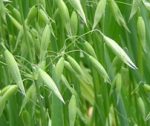 Wild oat is a tufted cool season annual in the grass family, Poaceae, that also includes bamboo, rice, and corn. It is native to Eurasia but is widely naturalized throughout the world including most of the US where it is a weed in fields of grain crops and waste areas such as along roads and railroad tracks. Wild oat adapts to a wide range of soil conditions and is especially troublesome growing among field crops such as wheat and cultivated oat because it significantly decreases the yield.Description: With an extensive fibrous root system, wild oat produces smooth, thick , hallow stems one to four feet tall with narrow dark green leaves three to eight inches long. The flowers appear in loose pendent panicles of two to three spiklets from late spring to early summer and are followed by seed that have covers with one to two ” long spike like structures, awns, at one end. When the awns get wet they twist and help work the seeds into the soil. The spread of wild oat is by the seeds that may be viable for up to five years. Plants turn brown by mid summer.
Wild oat is a tufted cool season annual in the grass family, Poaceae, that also includes bamboo, rice, and corn. It is native to Eurasia but is widely naturalized throughout the world including most of the US where it is a weed in fields of grain crops and waste areas such as along roads and railroad tracks. Wild oat adapts to a wide range of soil conditions and is especially troublesome growing among field crops such as wheat and cultivated oat because it significantly decreases the yield.Description: With an extensive fibrous root system, wild oat produces smooth, thick , hallow stems one to four feet tall with narrow dark green leaves three to eight inches long. The flowers appear in loose pendent panicles of two to three spiklets from late spring to early summer and are followed by seed that have covers with one to two ” long spike like structures, awns, at one end. When the awns get wet they twist and help work the seeds into the soil. The spread of wild oat is by the seeds that may be viable for up to five years. Plants turn brown by mid summer.
Control: Since plants are annuals and reproduce only by seed eliminating seed set is of vital importance. Since the seeds may be viable for several years, patience and consistent effort are necessary. Mulch to inhibit seed germination. Hoe, mow, or cut down plants as soon as they emerge to prevent seed set. For large scale infestations in grain fields crop rotation, selective herbicides, and controlled burning may be options.